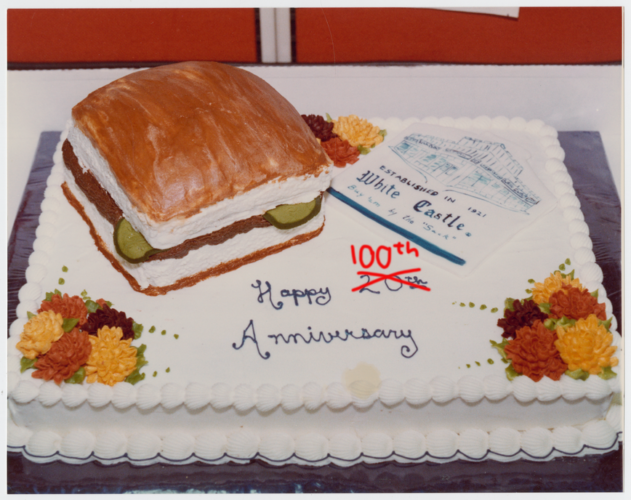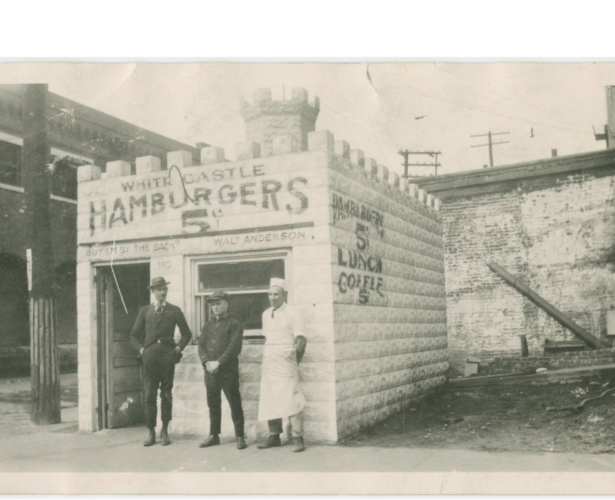Happy Birthday, White Castle!

Hey White Castle, Happy Birthday! In honor of your 100th anniversary, we thought we’d share with everyone some of our favorite bits from the archives.
Did you know the first White Castle was actually number 4? E. W. “Billy” Ingram, insurance and real-estate agent and founder of White Castle, first had the idea for the restaurant after meeting Walt Anderson, a fry cook and business owner in Wichita, Kansas. Back in the day, most people knew hamburgers as a meatball on buns, but when Anderson offered his “flat meatball” hamburger to Ingram after purchasing a house from him, Ingram offered to finance the dish as the specialty of a new restaurant–White Castle. Now, Ingram had three burger stands in Wichita already, so when Ingram designed the iconic castle look, it was technically the fourth burger stand in the area. The picture shown here may be “number 4,” but it was the first white castle White Castle in the business; the other three were later remodeled after this location.

So, why the white castle? In 1921 when the first White Castle opened, the public still had some mistrust for fast food restaurants lingering from sanitation issues in the meatpacking industry. Although addressed for years at that point by the Pure Food and Drug Act of 1906, the misperception still lingered. So, Ingram held high expectations for the appearance of White Castle employees and drew up plans for the sparkling stainless steel counters and spotless white exteriors. When he proposed the idea to Anderson, he said “we’ll call it the White Castle and we’ll operate the cleanest place in town.” These high standards, implemented at all locations, became a model for the chain restaurant, assuring customers that they would receive the same high-quality food at any White Castle they visited.

And the Crave caught on! From there, White Castle grew quickly, as you can see in one of my personal favorites from the archives, a company newsletter from 1926. The company newsletter would later be called the “White Castle Official House Organ,” but in the beginning it went by the more whimsical “Hot Hamburger.” This issue of the Hot Hamburger released some updated statistics for the company–over 3 million hamburgers sold in 1925, along with 48,000 gallons of coffee, which was about 50% more than in 1924. Quite the growth! My favorite highlight from the issue is a poem written by an assistant manager, entitled “Nickel Talk”:
I am Five-Cents.
Not on speaking terms with the butcher.
Too small to buy vegetables.
Not large enough for the baker.
Hardly fit for the grocer.
But, believe me, when I go to a White Castle I am considered SOME MONEY.
And as you can see painted on the exterior of the first White Castle, both hamburgers and coffee were five cents each. Some money, indeed!

Not only did White Castle innovate the notion of chain restaurants and popularize takeout with their iconic and affordable sliders, these weren’t the only inventions to come out of the White Castle kingdom! Under the auspices of their experimental kitchens, Ingram and fellow White Castle innovators developed the stainless steel spatula–a staple in kitchens nowadays. Paper caps replaced the linen caps of the original uniform, and production under Ingram’s Paperlynen Co. became another common sight in the fast food industry.
You can learn even more about White Castle’s history from the timeline on their website. Many of the images featured there may look familiar if you’ve browsed the White Castle digital collection on Ohio Memory. That’s because Ohio History Connection serves as the repository for the White Castle corporate archives! Thank you, White Castle, for sharing your history with us and helping us share it with the rest of the world. Long live the Crave!
Thank you to Jen Cabiya, Digital Projects Coordinator at the Ohio History Connection, for this week’s post!



Leave a Reply
You must be logged in to post a comment.